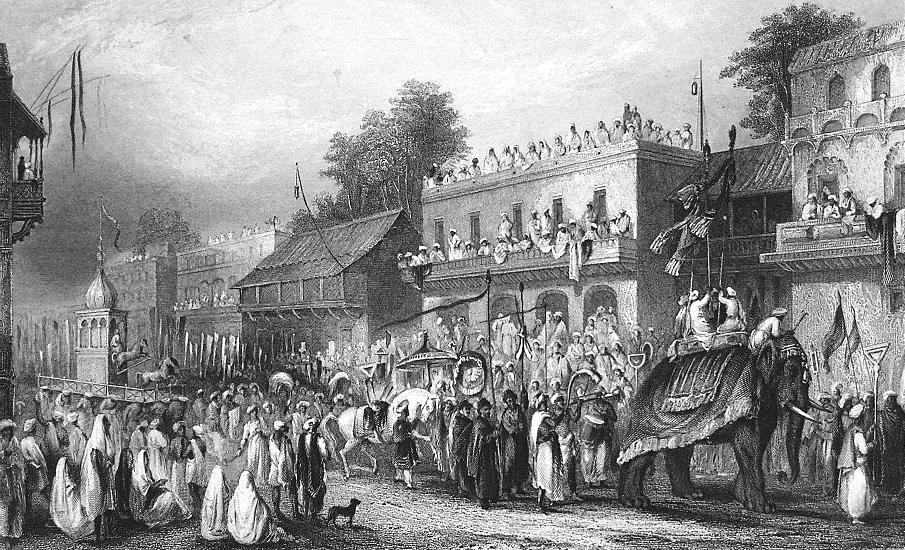The
observance of Muharram dates back to Sultanate period in north India. But its
representation in paintings is extremely rare before the arrival of the British.
No painting depicting Muharram procession or mourning assembly during Delhi Sultanate
has so far been traced. Similarly, no Muharram painting of Mughal era has been located.
It is quite surprising, for festivals like Holi have found place in the works
of painters active during Mughal period. Muharram also does not figure in the miniature
paintings produced during the reign of Jahangir. His rule is considered to be
golden period of Mughal paintings. Jahangir specially focused on miniatures and
they are available in large number but none probably presents any Muharram
ceremony. This feature is again strange, considering the fact that Jahangir’s
wife was an Imami and her entire family was held in high esteem by the emperor.
Jahangir has never been described as a liberal monarch like his illustrious father
Akbar the Great. But no Muharram painting of Akbar’s has also been found as
yet.
Since
Akbar’s father Humayun had won back the throne of Hindustan with the help of
Persian King, he only allotted place for keeping tazias but never engaged any
painter to portray observance of Muharram. Shahjahan too ignored likewise and his
successor and son Aurangzeb is infamous for his anti-Imami attitude. Later Mughals
remained too preoccupied with their own problems and failed to patronize any
form of art. The absence of Muharram paintings during Muslim rule over India
indicates that Imamis did not profess their faith openly and they mostly
remained under taqaiyya. The approach of Feroz Tughlaq against Imamis and barbaric
execution of Qazi Nurullah Shustri is pointer to the fact that despite enjoying
high ranks in the court, pro-Ahlebait elements passed their lives with caution.
Under such circumstances, no Imami noble could have dared to direct any artist
to prepare a Muharram painting. As there were no patronisers and takers, painters
too refrained themselves from paintings depicting the observance of Muharram.
Things
took a drastic change after the arrival of British. A number of paintings and
prints of Muharram processions and majlises are available and most of them were
the result of patronage extended by the British Sahibs in 18th and 19th
century. As new entrants, the British were interested in learning the Indian
customs, festivals and culture. Since photography had yet to take birth, Europeans
living and working in the Indian
subcontinent, especially British employees of the East India Company engaged
artists to depict Indian festivals. They even commissioned Indian artists like Sitaram
for the purpose. The outcome of such endeavors is called as company paintings
and Muharram figures very prominently in the colonial paintings. These
paintings represent fusion of traditional Indian artistic styles with
conventions and technical features borrowed from western art. A famous painting
in which Muharram has been depicted is part of an album, known as the Gentil
Album, commissioned by a French infantry colonel, Jean-Baptiste-Joseph Gentil
(1726-1799).He had served under Nawab Shuja-Ud-Daula of Awadh. Another
interesting Muharram painting was done by Colonel Robert Smith (1787-1873) .Painted with oil on canvas, the painting
shows a Muharram procession proceeding to Bara Imambara in Lucknow.
Nawabs
of Murshidabad despite their subordination to East India Company never
compromised with the grandeur of Muharram ceremonies. Being Imami they not only
observed Muharram with royal touch but also commissioned artists to represent
Azadari rituals in paintings like the British. There is a group of nine
paintings, depicting a durbar (public reception)
at Murshidabad, various Hindu and Muslim festivals.A local artist copied it, probably from an original oil painting by George Farington. He had remained in Murshidabad from 1785 to 1788. His original painting is lost but its copy is still preserved. This painting shows Muharram processionists, carrying 'tazias' (replica of Imam Hussain’s shrine at Karbala) for immersion in the river. A very impressive Muharram painting represents patna. This painting demonstrates with how much grandeur and mass participation Muharram was observed in Patna (See Below)
 |
| Painting Attributed to Colonel Robert Smith |
A very beautiful painting of muharram Procession in black and white colors is also worth mentioning here . It was printed undewr the title "Festival of the Moharram, Funeral of Houssein and Hoossein, India," by H. Melville, Fisher, Son, & Co., in 1840 in London.( See Pic. below)
 |
In the context of colonial Muharram paintings, Alam Musawwir also
deserves to be mentioned. A 19th century artist, he drew the famous Muharram Procession
paintings of Dhaka in water color.. Nothing is known about the personal life of
Alam. He was a contemporary of Nawab Nusrat Jung and presumably painted the
procession series under his patronage. Alam Musawwir's Muharram Procession
paintings portray the life style of the Nawab and his retinue, Company
officials, and commoners as well as destitute. These paintings also represent
important landmarks of old Dhaka, such as the palace and the portals of the Naib-i-Nazim
of Dhaka at Nimtali. Musawwir and his pupils worked on hand-made paper a little
larger in size as compared to Mughal miniatures. His style is influenced by
both Mughal qalam and the Company style. Musawwir is known for using an
indigenous color scheme with some traces of European perspective. (References
available on request- Pix courtesy- Google Images))
No comments:
Post a Comment